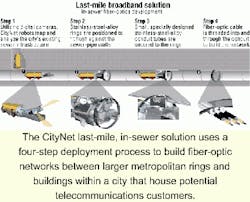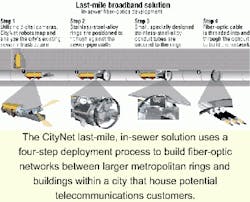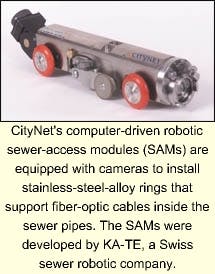Pulling fiber through city sewers bridges 'last mile'
By ROBERT PEASE
The nightmare of destroying city streets and disrupting rush-hour traffic in large metropolitan areas has telecommunications companies seeking alternative methods of bridging the "last mile" with optical fiber. One company has discovered a unique pathway for connecting telecommunications companies and network service providers to their commercial and multitenant customers via fiber-the city's existing sewer system. CityNet Telecommunications Inc. (Silver Springs, MD) is using a radical, patented robotic technology to lay fiber-optic cables in sewer pipes to provide much-needed capacity deeper into the metro area.
CityNet uses robots known as sewer-access modules (SAMs) developed by robotics technology company KA-TE Systems Ltd. of Zurich. The custom-designed remotely controlled SAMs can install fiber-optic networks in sewer pipes as small as 8 inches in diameter. Each computer-driven SAM is equipped with cameras to install stainless-steel-alloy rings that support the fiber-optic cables inside the pipes. The conduit that encases the fiber is made of the same stainless-steel alloy that protects the fiber from corrosion and cuts.
"The in-sewer deployment is a four-part process," says Robert Berger, chairman and CEO at CityNet. "Utilizing digital video cameras, our SAM inspects and maps the city's existing sewer infrastructure and then installs stainless-steel-alloy rings that are positioned every 3 to 5 feet, fit flush against the sewer-pipe walls. Small, specially designed stainless-steel-alloy conduit is secured to clamps in the crown of the rings inside the sewer pipe by the SAM. Fiber-optic cable is then threaded into or blown through the conduit to complete the fiber-optic network."During the inspection process, video cameras mounted on the SAMs record the condition of every sewer line proposed for fiber installation. Based on inspection data, CityNet can ascertain whether pipes require minor repairs or other maintenance. The fiber is deployed in current, not abandoned, sewer systems. The rings and conduit have previously undergone extensive testing in actual sewer-flow environments to ensure they are impervious to corrosion and other sewer environmental factors.
The prospect of snaking fiber through existing sewer pipes-and using robots to do it-is an appealing proposition for reaching customers with fiber. The obvious advantage is the ability to bypass the bottlenecks typically associated with last-mile fiber access to buildings within cities. The cost of connecting buildings to larger "beltway" city fiber rings is enormous. The huge costs involved with trenching roads, right-of-way deals, and traffic disruption are avoided by using an existing network of sewer pipes that already exit from every building.
"Our deployment technique is less expansive than traditional fiber-plant construction," says Berger. "The major advantage, however, with our last-mile network-deployment technique is speed. CityNet can deploy approximately 60% faster than traditional fiber-network construction."
The network architecture involves a ring topology, providing complete redundancy to the network. Depending on the density of its market, a city could support between three and six rings, with each connecting directly into an average of 30 to 60 commercial and multitenant residential buildings.
"Each mini-ring will also connect to an average of four aggregation points such as central office or carrier hotels," says Berger. "Our fiber-optic cables run up each building's lateral and terminate in the basement of the building itself."
CityNet has project agreements with three cities-Albuquerque, NM; Indianapolis; and Omaha, NE-with ongoing planning and design stages already in motion for at least 16 other cities. Construction is underway in the first "last mile" mini-ring in Albuquerque, scheduled for completion next month. Depending on climatic conditions, a ring in Indianapolis will follow.
"CityNet is also in negotiations and discussions with more than 50 carriers and network service providers to lease last-mile dark fiber," says Berger. "Although KA-TE holds all patents related to the actual robots, all intellectual property that results from CityNet's network design and deployment will be owned by CityNet."Europe has been a test bed of sorts for building fiber-optic networks within a city's sewer infrastructure. Several German cities, including Hamburg, Regensburg, and Hanau, have deployed the technology. Alcatel Kabel, a division of Alcatel, worked in conjunction with KA-TE and IK-T, a European engineering company, to develop a network platform in Europe called FAST. This system was the first complete platform to enable fiber to be deployed in this way-not just in man-entry sewer systems, but also in no-man-entry pipes.
A special cable with up to 144 fibers can be installed directly or pulled later through the sewer-pipe system. Since sewers are traditionally located deeper than most civil works, there is built-in protection against damage through excavation work. Each deployment is conducted through individual negotiations with city-government water and sewer agencies. CityNet plans to expand the technology into North American cities.
CityNet's discussions with KA-TE began early last year. The strategic partnership that resulted involves the purchase of robotic systems from KA-TE. To date, CityNet has purchased 54 robotic systems, each including two robots, software, and other operating equipment. CityNet also has the first right-of-refusal on all KA-TE robotic systems for North America through 2001. The two companies have also agreed on joint marketing and communications activities.
Besides KA-TE, CityNet's partners include Alcatel (Paris), which first introduced CityNet to KA-TE; CableRunner North America LLC, which provides in-sewer fiber-optic network-deployment technology for man-accessible sewers; and Carter & Burgess, a large architecture, engineering, and construction-management firm.
"CityNet's core mission and focus is solving the infamous 'last-mile' problem with an all-optical network that doesn't tear up streets or cause traffic disruptions," says Berger. "Our in-sewer deployment offers a win-win situation for all involved. For telecom carriers and network service providers, it's a true, end-to-end last-mile fiber-optic network that they control. For cities, it's a unique and powerful economic development tool, added revenue from an existing infrastructure, and of course, protection from damage to roads and problems with traffic. For building owners and managers, we provide a major upgrade for their buildings for free-which, in turn, adds to the value of the building."


